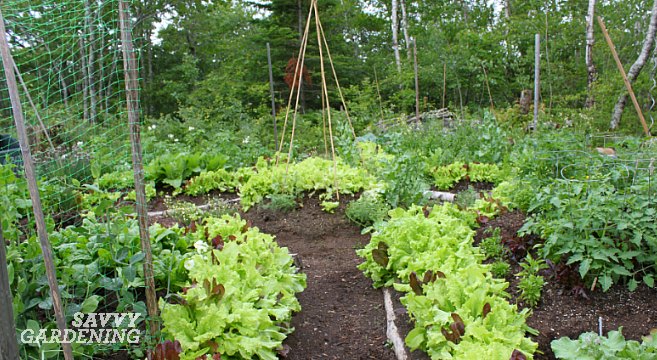This post may contain affiliate links. If you make a purchase through links on our site, we may earn a commission.
You don’t need a big garden to produce a large harvest. Growing high-yield vegetables is an easy way to maximize your growing space. High-yield crops are those that produce the most food per square foot of garden. There are plenty of great books on growing more food with less space, including the recently released book, High-Yield Vegetable Gardening by Colin McCrate and Brad Halm.
6 high-yield vegetables
I practice high-yield gardening in my own raised bed garden and here are a few of my favourite crops that give the best bang for your buck:
1. Pole beans
Pole beans are vigorous climbers, and can grow 10 feet or more to ramble over fences, teepees, trellises, or netting. As well, they consistently out-yield bush beans when grown in the same amount of space. My favourite varieties include ‘French Gold’, ‘Emerite’, ‘Rattlesnake’, and ‘Purple Podded Pole’.

2. Peas
Just-picked peas are a true garden treat and most of ours are devoured while standing in the pea patch. Like pole beans, peas are grown vertically, taking up a minimum of garden space, but producing a heavy crop for several weeks. I love experimenting with different pea varieties, but I always come back to ‘Super Sugar Snap’. This variety has it all – plump edible pods and sweet juicy peas that are produced on 5 foot tall vines.
3. Zucchini
Zucchini is often considered a garden thug, growing vigorously and taking up more than its fair share of space. However, zucchini plants are also food factories, pumping out a ridiculously generous harvest. I’m obsessed with ‘pattypan’ types like ‘Sunburst’ and ‘Bennings Green Tint’, the heirloom ‘Costata Romanesco’, and Lebanese types like ‘Clairmore’.

4. Salad greens
Salad greens like lettuce, spinach, and arugula are high-yield superstars! They are super speedy to grow and can be planted in small spaces and containers. Use greens to edge a garden bed, fill the space beneath a pole bean teepee or A-frame trellis, or as a living mulch between slower growing crops. For lettuce, I rely on looseleaf varieties like ‘Red Sails’, ‘Red Salad Bowl’, and ‘Drunken Woman’. ‘Corvair’ and ‘Tyee’ are among my favourite spinach cultivars and ‘Astro’ is a reliable arugula with dark green, deeply lobed leaves.
5. Tomatoes
Tomatoes are the #1 garden crop in North America, but they are also a high-yield vegetable that can produce a heavy crop over an extended period of time. We grow a wide range of heirloom and hybrid varieties, with cherry ones like ‘Sungold’ and ‘Jasper’ being extremely prolific, and large fruited varieties like ‘Mountain Merit’ and ‘Chef’s Choice Orange’ taking us from mid-summer to the autumn frost.
6. Cucumbers
Cucumbers are produced on either bush or vining plants. Bush varieties have tidy growth and can be popped into containers or small garden beds, but produce fewer fruits per plant than vining types. Vining cucumbers, on the other hand, will ramble over open ground or quickly scale a fence, A-frame trellis, or netting. We love the heirlooms ‘Lemon’ and ‘Boothby’s Blonde’, and hybrids like ‘Diva’ or ‘Pick a Bushel’.

Looking for more ways to boost yield in your garden? Try combining the above high-yield vegetables with sneaky space-saving techniques like intensive planting, vertical growing, interplanting and succession planting.




I love growing cucumbers but I hate cucumber beetles. The year I grew pumpkins & squash alone, things were happy. The next year I added cucumbers and every beetle within a hundred miles came to the garden and OMG these things have two things on their mind: (1) eating leaves, and (2) procreating. Being a conscientious organic gardener I shop vac’d the beetles twice a day. Still could not keep up. Anything in the squash family was savaged by these beasts. No more cukes!
Yes took hours of killing them and spraying natural sprays. There were so many squash beetles and carpet beetles that I ended up loosing lots of the plants (5 out of 10 got eaten)
HI,
I live in the UK and as the weather is so unpredictable I grow all my tomatoes in my greenhouse in large pots. This way I can fit more plants in without over crowding. I find that as long as I feed them with comfrey tea once a week they do just fine.
I try to grow both pole peas and snap peas, and every year my pea plants yellow at the base even though I use compost, fish emulsion and rotate them each year. What else can I do? I’m about to quit trying to grow peas.
Frustrating! There are several fungal problems that may be to blame. Therefore, crop rotation is key, which you mention, but I would try to put them on a four year rotation if possible. Or, stop growing them in your garden for a few years and instead plant peas in pots. There are some awesome varieties that grow great in pots. I’d also suggest that when you do plant them in the garden again, use compost, as you have been, but also mulch the soil with straw as the plants grow to minimize the spread of any fungal spores. Be sure to plant in sunshine too and don’t overcrowd plants so air circulation is good. Hope this helps. Keep us posted! Good luck, Niki
Niki….Thanks for the advice. I’m afraid I’m just going to have to stop growing peas for awhile. My other veggies don’t seem to have a problem, so I’ll stick with them.
L.C.
LCD I grow mine in containers, works great for me